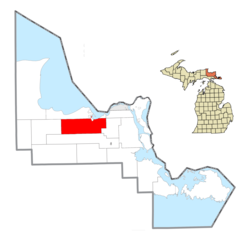Superior Township, Michigan | |
|---|---|
 Community of Brimley along W. 6 Mile Road | |
 Location within Chippewa County | |
| Coordinates: 46°22′40″N84°39′28″W / 46.37778°N 84.65778°W | |
| Country | United States |
| State | Michigan |
| County | Chippewa |
| Government | |
| • Supervisor | Richard Phillips |
| Area | |
• Total | 104.7 sq mi (271.1 km2) |
| • Land | 103.0 sq mi (266.7 km2) |
| • Water | 1.7 sq mi (4.4 km2) |
| Elevation | 810 ft (247 m) |
| Population (2020) | |
• Total | 1,276 |
| • Density | 12/sq mi (4.7/km2) |
| Time zone | UTC-5 (Eastern (EST)) |
| • Summer (DST) | UTC-4 (EDT) |
| ZIP code | 49715 (Brimley) |
| Area code | 906 |
| FIPS code | 26-77540 [1] |
| GNIS feature ID | 1627140 [2] |
Superior Township is a civil township of Chippewa County in the U.S. state of Michigan. The population was 1,276 at the 2020 census. [3]
Contents
The federally recognized Bay Mills Indian Community has part of its land base reservation in Superior Township, based west of Brimley. It operates two casinos on its reservation, one of which is in Superior Township, to generate funds for education and welfare of its people. Brimley State Park is also within the township on the shores of Lake Superior.

